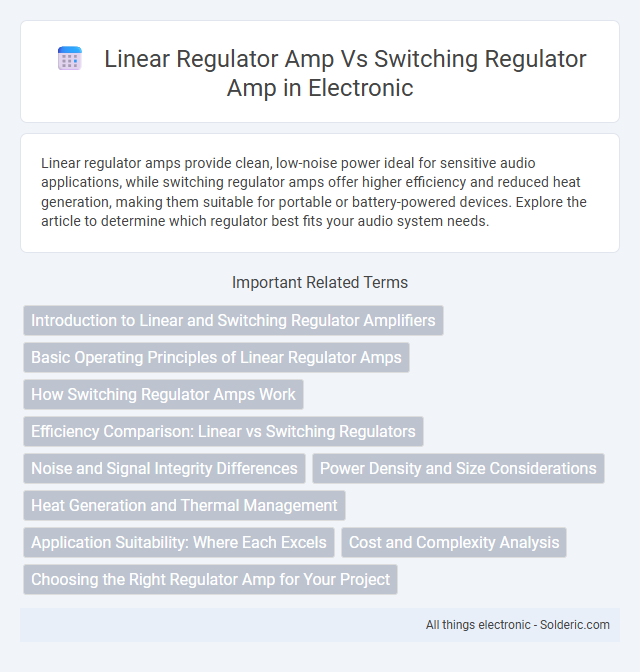Linear regulator amps provide clean, low-noise power ideal for sensitive audio applications, while switching regulator amps offer higher efficiency and reduced heat generation, making them suitable for portable or battery-powered devices. Explore the article to determine which regulator best fits your audio system needs.
Comparison Table
| Feature | Linear Regulator Amp | Switching Regulator Amp |
|---|---|---|
| Efficiency | Low (30-60%) | High (80-95%) |
| Heat Dissipation | High (needs large heat sink) | Low (minimal heat generated) |
| Size | Larger (due to heat sinks) | Compact (smaller components) |
| Complexity | Simple design | Complex circuitry |
| Noise | Low electrical noise | High switching noise (requires filtering) |
| Cost | Lower initial cost | Higher initial cost due to components |
| Output Quality | Clean, low ripple voltage | Moderate ripple, needs additional filtering |
| Use Cases | Audio applications needing low noise | High power and portable devices |
Introduction to Linear and Switching Regulator Amplifiers
Linear regulator amplifiers provide a stable output voltage by dissipating excess power as heat, ensuring low noise and precise regulation ideal for sensitive analog circuits. Switching regulator amplifiers convert voltage efficiently using high-frequency switching elements, minimizing power loss and delivering higher current output suitable for power-hungry digital devices. The choice between linear and switching regulator amplifiers depends on factors like efficiency requirements, noise tolerance, and thermal management in electronic designs.
Basic Operating Principles of Linear Regulator Amps
Linear regulator amplifiers operate by dissipating excess voltage as heat to maintain a constant output voltage, providing low noise and minimal ripple ideal for sensitive audio applications. Unlike switching regulator amps, they do not use high-frequency switching components, resulting in simpler design and quieter operation but lower efficiency. Your choice depends on the trade-off between power efficiency and signal purity.
How Switching Regulator Amps Work
Switching regulator amps use high-frequency pulse-width modulation (PWM) to control the voltage conversion process, rapidly switching the input power on and off to regulate output voltage efficiently. This method minimizes power loss by transferring energy through inductors and capacitors, resulting in higher efficiency compared to linear regulators, which dissipate excess voltage as heat. Switching regulators can support higher current loads while maintaining stable output voltage and reduced thermal stress, making them ideal for power-sensitive and high-performance audio applications.
Efficiency Comparison: Linear vs Switching Regulators
Switching regulators typically achieve efficiencies between 80% to 95%, significantly outperforming linear regulators, which generally operate at 40% to 60% efficiency, especially under large voltage differentials. Linear regulators dissipate excess voltage as heat, causing reduced efficiency and increased thermal management challenges. Higher efficiency in switching regulators results from energy conversion through inductors and capacitors rather than resistive dissipation, making them ideal for power-sensitive applications.
Noise and Signal Integrity Differences
Linear regulator amplifiers produce significantly lower noise compared to switching regulator amplifiers due to their simple design and absence of high-frequency switching elements, ensuring superior signal integrity in sensitive analog circuits. Switching regulator amplifiers generate higher electromagnetic interference (EMI) and switching noise, which can degrade signal quality and require complex filtering to maintain signal integrity. Consequently, linear regulators are preferred for low-noise applications such as precision analog and RF systems, while switching regulators are typically used where efficiency outweighs noise considerations.
Power Density and Size Considerations
Linear regulator amps typically have lower power density due to their larger heat dissipation components, making them bulkier and less efficient for high-power applications. Switching regulator amps boast higher power density by converting energy more efficiently, allowing for smaller size and reduced thermal management requirements. Your choice between the two will depend on space constraints and power efficiency needs, with switching regulators favored for compact, high-power designs.
Heat Generation and Thermal Management
Linear regulator amps generate significantly more heat due to their continuous voltage drop during operation, requiring robust thermal management solutions like heat sinks and cooling fans to maintain optimal performance. Switching regulator amps operate with higher efficiency, producing less heat by rapidly switching current on and off, which reduces thermal stress and simplifies cooling requirements. Understanding these differences helps you choose the appropriate amplifier for your application's thermal constraints and reliability needs.
Application Suitability: Where Each Excels
Linear regulator amps excel in low-noise, precision-sensitive applications such as audio equipment and sensitive analog circuits due to their clean, ripple-free output and simplicity. Switching regulator amps are better suited for high-efficiency, high-current scenarios like battery-powered devices, DC-DC converters, and power-hungry digital systems where minimizing heat dissipation and maximizing energy efficiency are crucial. The choice depends on application-specific requirements regarding noise tolerance, power efficiency, heat management, and voltage conversion complexity.
Cost and Complexity Analysis
Linear regulator amps typically have lower cost and simpler design due to fewer components and straightforward operation, making them ideal for low-power applications. Switching regulator amps, while more complex and costly because of additional components such as inductors and switching transistors, offer higher efficiency and better thermal management in high-power scenarios. Your choice depends on balancing budget constraints against performance requirements.
Choosing the Right Regulator Amp for Your Project
Choosing the right regulator amp for your project depends on efficiency, noise tolerance, and complexity. Linear regulator amps offer low noise and simplicity, making them ideal for sensitive audio applications but generate more heat and consume more power. Switching regulator amps provide higher efficiency and better thermal management, suitable for battery-powered or high-current projects where minimizing energy loss is critical.
linear regulator amp vs switching regulator amp Infographic

 solderic.com
solderic.com